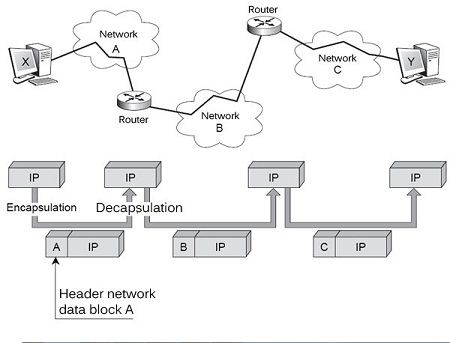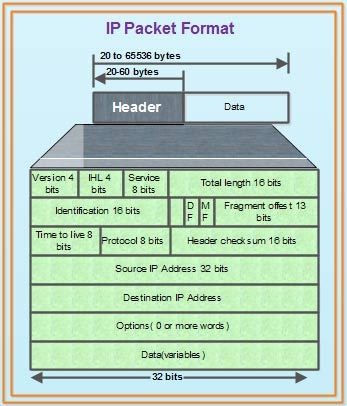The Internet’s basic protocol called IP for Internet Protocol. The objective of starting this protocol is assigned to interconnect networks do not have the same frame-level protocols or package level. The internet acronym comes from inter-networking and corresponds to an interconnection fashion: each independent network must transport in the weft or in the data area of the packet an IP packet, as shown in Figure.
There are two generations of IP packets, called IPv4 (IP version 4) and IPv6 (IP version 6). IPv4 has been dominant so far. The transition to IPv6 could accelerate due to its adoption in many Asian countries. The transition is however difficult and will last many years.
• Internet Protocol (IP) of network layer contains addressing information and some control information that enables the packets to be routed.

• IP has two primary responsibilities:
1. Providing connectionless, best effort delivery of datagrams through a internetwork. The term best effort delivery means that IP does not provides any error control or flow control. The term connectionless means that each datagram is handled independently, and each datagram can follow different route to the destination. This implies that datagrams sent by the same source to the same destination could arrive out of order.
2. Providing fragmentation and reassembly of datagrams to support data links with different maximum transmission unit (MTU) sizes.
IP packet format
• Packets in the network layer are called datagrams.
A datagram is a variable length packet consisting of two parts: header and data.
• The header is 20 to 60 bytes in length and contains information essential to routing and delivery.
• The various fields in IP header are:
1. Version: It is a 4-bit field that specifies the version of IP currently being used. Two different versions of protocols are IPV4 (Internet Protocol Version 4) and IPV6 (Internet Protocol Version 6).
2. IP Header Length (IHL): This 4-bit field indicates the datagram header length in 32 bit word. The header length i8 not constant in IP. It may vary from 20 to 60 bytes. When there are no options, the header length is 20 bytes, and the value of this field is 5. When the option field is at its maximum size, the value of this field is 15.

3. Services: This 8 hit field was previously called services type but is now called differentiated services.
The various bits in service type are:
• A 3-bit precedence field that defines the priority of datagram in issues such as congestion. This 3-bit subfield ranges from 0 (000 in binary) to 7 (111 in binary).

• After 3-bit precedence there are four flag bits. These bits can be either 0 or 1 and only one of the bits can have value of 1 in each datagram.
The various flag bits are:
D : Minimize delay
T : Maximize throughout
R : Maximize reliability
C : Minimize Cost
The various bits in differentiated services are:
• The first 6 bits defined a code-point and last two bits are not used. If the 3 rightmost bits are 0s, the 3 leftmost bits are interpreted the same as the precedence bits in the service type interpretation
4. Total length: This 16 bit field specifies the total length of entire IP datagram including data and header in bytes. As there are 16 bits, the total length of IP datagram is limited to 65,535 (216 – 1) bytes.
5. Identification: This 16 bit field is used in fragmentation. A datagram when passing through different networks may be divided into fragments to match the network frame size. Therefore, this field contains an integer that identifies the current datagram. This field is used to help piece together datagram fragments.
6. Flags: Consists’ of a 3 bit field of which the two low order bit DF, MF control fragmentation. DF stands for Don’t Fragment. DF specifies whether the packet can be fragmented MF stands for more fragments. MF specifies whether the packet is the last fragment in a series of fragmented packets. The third or high order but is not used.
7. Fragment Offset: This 13 bit field indicates the position of the fragment’s data relative to the beginning of the data in the original data-gram, which allows the destination IP process to properly reconstruct the original datagram.
8. Time to Live: It is 8 bit field that maintain a counter that gradually decrements down to zero, at which point the datagram is discarded. This keeps the packet from looping endlessly.
9. Protocol: This 8 bit field indicates which upper layer protocol receives incoming packets after IP processing is complete.
10. Header Checksum: This 16 bit field contains a checksum that covers only the header and not the data.
11. Source IP address: These 32-bit field contains the IP address of source machine.
12. Destination IP address: This 32-bit field contains the IP address of destination machine.
13. Options: This field allows IP to support various options such as security, routing, timing management and alignment.
14. Data: It contains upper layer information.
 Dinesh Thakur holds an B.C.A, MCDBA, MCSD certifications. Dinesh authors the hugely popular
Dinesh Thakur holds an B.C.A, MCDBA, MCSD certifications. Dinesh authors the hugely popular